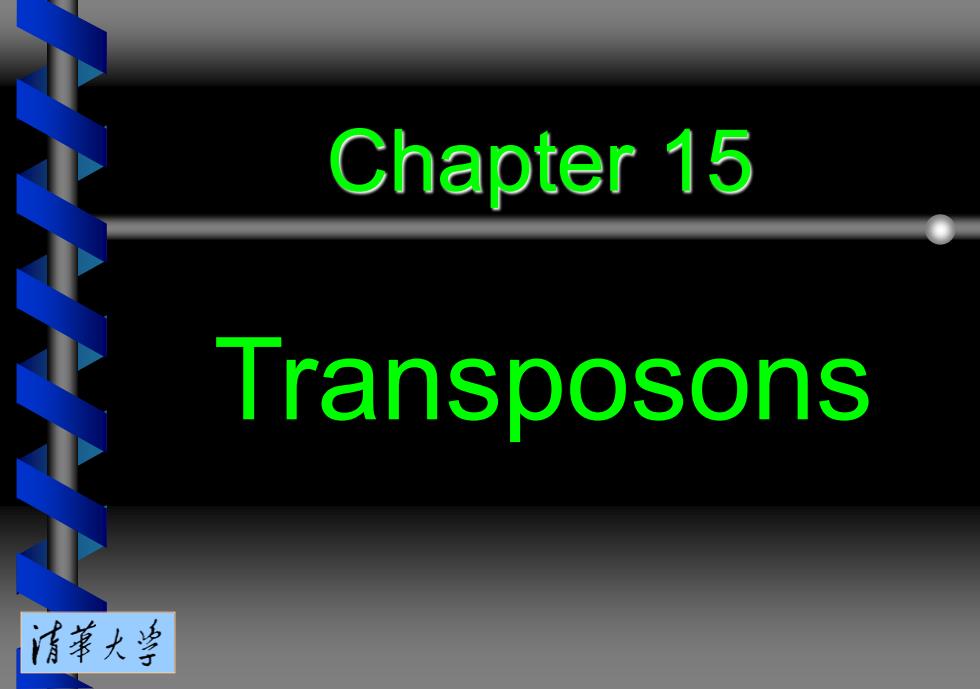
Chapter 15 Transposons 清第大当
Chapter 15 Transposons

15.1 Introduction 15.2 Insertion sequences are simple transposition modules 15.3 Composite transposons have IS modules 15.4 Transposition occurs by both replicative and nonreplicative mechanisms 15.5 Transposons cause rearrangement of DNA 15.6 Common intermediates for transposition 15.7 Replicative transposition proceeds through a cointegrate 15.8 Nonreplicative transposition proceeds by breakage and reunion 15.9 TnA transposition requires transposase and resolvase 15.10 Transposition of Tn10 has multiple controls 15.11 Controlling elements in maize cause breakage and rearrangements 15.12 Controlling elements form families of transposons 15.13 Spm elements influence gene expression 15.15 P elements are activated in the germline 清苇大当
15.1 Introduction 15.2 Insertion sequences are simple transposition modules 15.3 Composite transposons have IS modules 15.4 Transposition occurs by both replicative and nonreplicative mechanisms 15.5 Transposons cause rearrangement of DNA 15.6 Common intermediates for transposition 15.7 Replicative transposition proceeds through a cointegrate 15.8 Nonreplicative transposition proceeds by breakage and reunion 15.9 TnA transposition requires transposase and resolvase 15.10 Transposition of Tn10 has multiple controls 15.11 Controlling elements in maize cause breakage and rearrangements 15.12 Controlling elements form families of transposons 15.13 Spm elements influence gene expression 15.15 P elements are activated in the germline
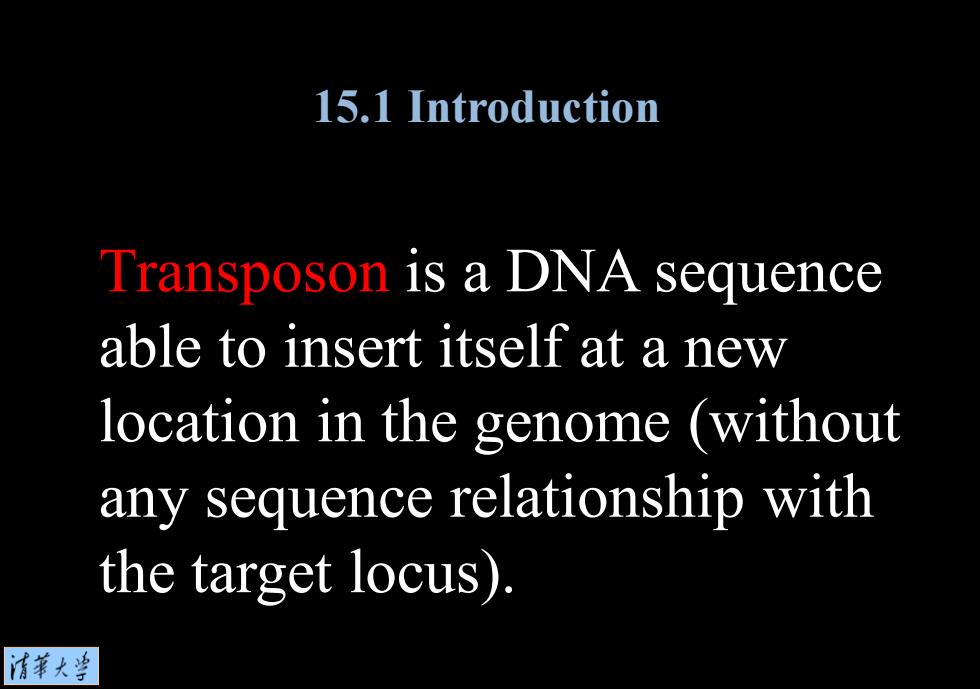
15.1 Introduction Transposon is a DNA sequence able to insert itself at a new location in the genome (without any sequence relationship with the target locus) 情莘大学
Transposon is a DNA sequence able to insert itself at a new location in the genome (without any sequence relationship with the target locus). 15.1 Introduction
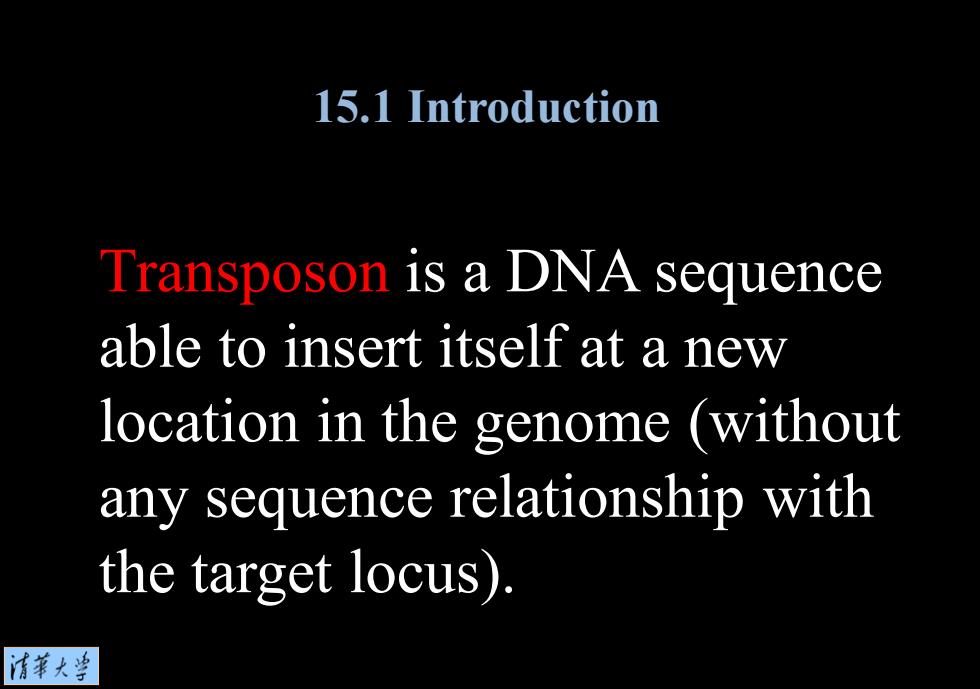
15.1 Introduction Transposon is a DNA sequence able to insert itself at a new location in the genome (without any sequence relationship with the target locus) 清苇大当
Transposon is a DNA sequence able to insert itself at a new location in the genome (without any sequence relationship with the target locus). 15.1 Introduction
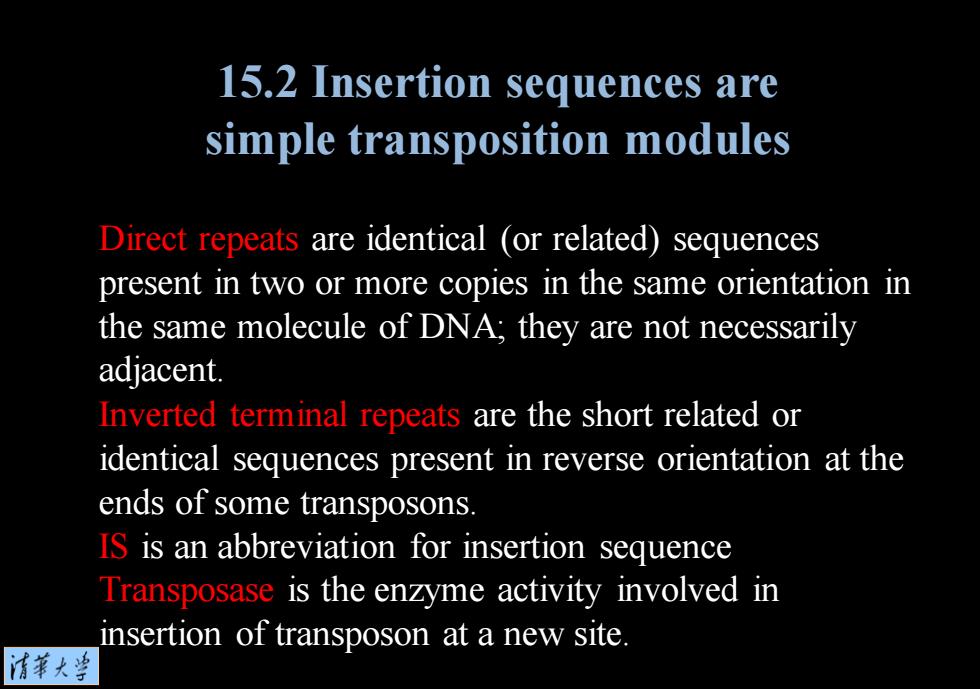
15.2 Insertion sequences are simple transposition modules Direct repeats are identical (or related)sequences present in two or more copies in the same orientation in the same molecule of DNA;they are not necessarily adjacent. Inverted terminal repeats are the short related or identical sequences present in reverse orientation at the ends of some transposons. IS is an abbreviation for insertion sequence Transposase is the enzyme activity involved in insertion of transposon at a new site. 清菜大当
Direct repeats are identical (or related) sequences present in two or more copies in the same orientation in the same molecule of DNA; they are not necessarily adjacent. Inverted terminal repeats are the short related or identical sequences present in reverse orientation at the ends of some transposons. IS is an abbreviation for insertion sequence Transposase is the enzyme activity involved in insertion of transposon at a new site. 15.2 Insertion sequences are simple transposition modules

15.2 Insertion sequences are simple transposition modules 123456789 987654321 123456789 987654321 Transposase gene Figure 15.1 Transposons have inverted terminal ATGCA TACGT repeats and generate direct Host DNA Target site Host DNA repeats of flanking DNA at the target site.In this example,the target is a 5 bp 88楞78 987654321ATCC 987654321TACG sequence.The ends of the Target Iwerted Transposon Irverted Target repeat repeat repeat repeat transposon consist of inverted repeats of 9 bp, Overall length Target selection random where the numbers 1 退 3F186298 品品品5 bb hotspots AAAN2OTTT through 9 indicate a R吧GCN sequence of base pairs. hotspots 的 random 清菜大当
Figure 15.1 Transposons have inverted terminal repeats and generate direct repeats of flanking DNA at the target site. In this example, the target is a 5 bp sequence. The ends of the transposon consist of inverted repeats of 9 bp, where the numbers 1 through 9 indicate a sequence of base pairs. 15.2 Insertion sequences are simple transposition modules
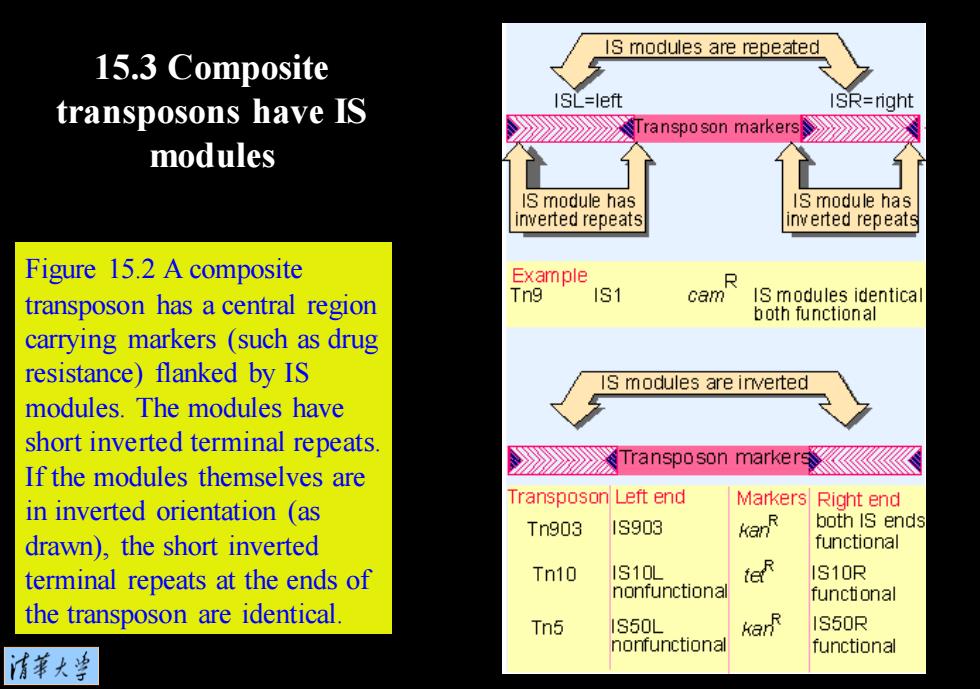
IS modules are repeated 15.3 Composite transposons have IS ISL=left SR=nght Transposon markers modules IS module has IS module has inverted repeats inv erted repeats Figure 15.2 A composite Example transposon has a central region Tn9 1S1 cam IS modules identical both functional carrying markers (such as drug resistance)flanked by IS IS modules are irverted modules.The modules have short inverted terminal repeats. Transposon markers If the modules themselves are in inverted orientation (as Transposon Left end Markers Right end Tn903 1S903 karR both IS ends drawn),the short inverted functional terminal repeats at the ends of Tn10 1S10L te IS10R nonfunctional functional the transposon are identical Tn5 1S50L ⑧ 1S50R nonfunctional functional 清菜大当
Figure 15.2 A composite transposon has a central region carrying markers (such as drug resistance) flanked by IS modules. The modules have short inverted terminal repeats. If the modules themselves are in inverted orientation (as drawn), the short inverted terminal repeats at the ends of the transposon are identical. 15.3 Composite transposons have IS modules
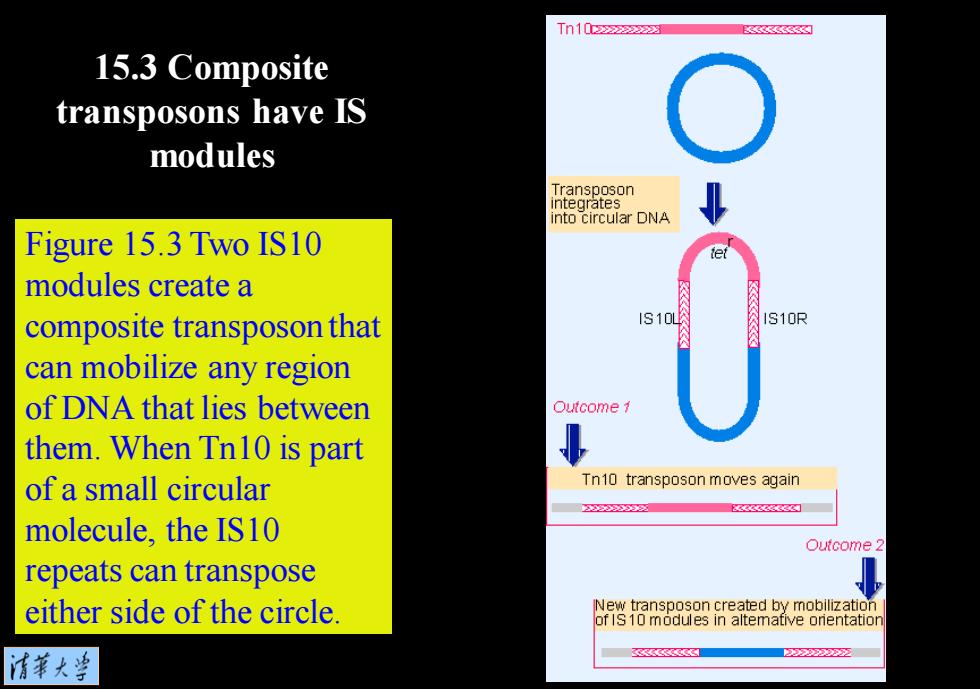
Tn102222222223 *333 15.3 Composite transposons have IS modules Transposon integrates into circular DNA Figure 15.3 Two IS10 modules create a composite transposon that 1S10L 1S10R can mobilize any region of DNA that lies between Outcome 1 them.When Tn10 is part of a small circular Tn10 transposon moves again 222223232% E3& molecule,the IS10 Outcome 2 repeats can transpose either side of the circle. New transposon created by mobilization of IS 10 modules in altemative onentatior 清第大当 ✉ 2222
Figure 15.3 Two IS10 modules create a composite transposon that can mobilize any region of DNA that lies between them. When Tn10 is part of a small circular molecule, the IS10 repeats can transpose either side of the circle. 15.3 Composite transposons have IS modules
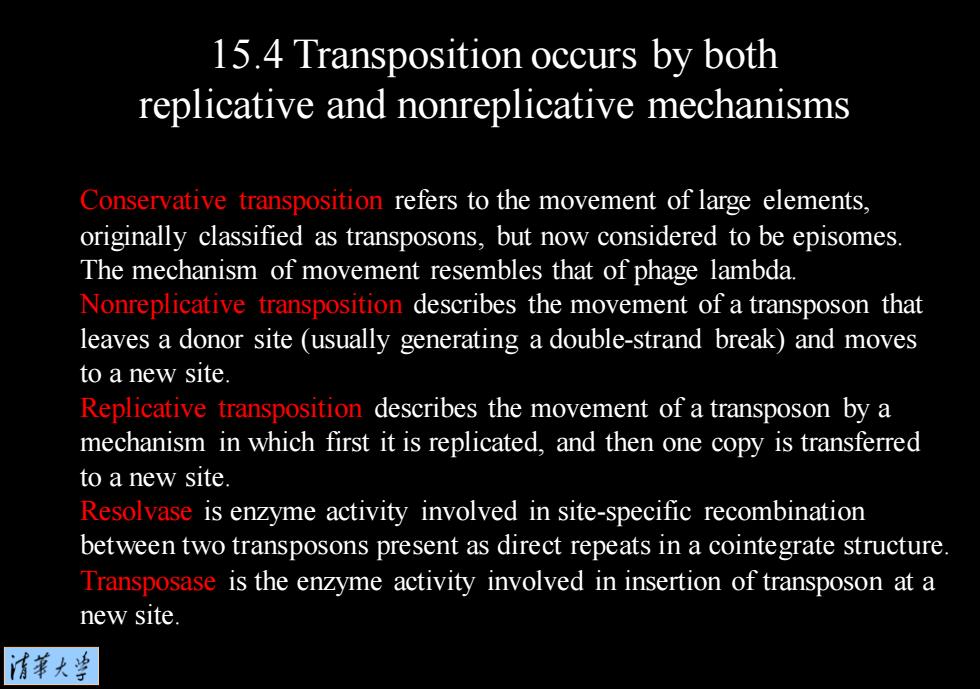
15.4 Transposition occurs by both replicative and nonreplicative mechanisms Conservative transposition refers to the movement of large elements, originally classified as transposons,but now considered to be episomes. The mechanism of movement resembles that of phage lambda. Nonreplicative transposition describes the movement of a transposon that leaves a donor site (usually generating a double-strand break)and moves to a new site. Replicative transposition describes the movement of a transposon by a mechanism in which first it is replicated,and then one copy is transferred to a new site. Resolvase is enzyme activity involved in site-specific recombination between two transposons present as direct repeats in a cointegrate structure. Transposase is the enzyme activity involved in insertion of transposon at a new site. 清菜大当
Conservative transposition refers to the movement of large elements, originally classified as transposons, but now considered to be episomes. The mechanism of movement resembles that of phage lambda. Nonreplicative transposition describes the movement of a transposon that leaves a donor site (usually generating a double-strand break) and moves to a new site. Replicative transposition describes the movement of a transposon by a mechanism in which first it is replicated, and then one copy is transferred to a new site. Resolvase is enzyme activity involved in site-specific recombination between two transposons present as direct repeats in a cointegrate structure. Transposase is the enzyme activity involved in insertion of transposon at a new site. 15.4 Transposition occurs by both replicative and nonreplicative mechanisms

15.4 Transposition occurs by both replicative and Target site nonreplicative mechanisms 1HHH111HHHHHH Figure 15.4 The direct Staggered +++H++H repeats of target DNA nicks made at target flanking a transposon ATGCA site are generated by the Transposon joined to introduction of single-stranded ends staggered cuts whose 8 protruding ends are Gaps at linked to the target site filled in transposon. arget repeats and sealed 清菜大兰
Figure 15.4 The direct repeats of target DNA flanking a transposon are generated by the introduction of staggered cuts whose protruding ends are linked to the transposon. 15.4 Transposition occurs by both replicative and nonreplicative mechanisms